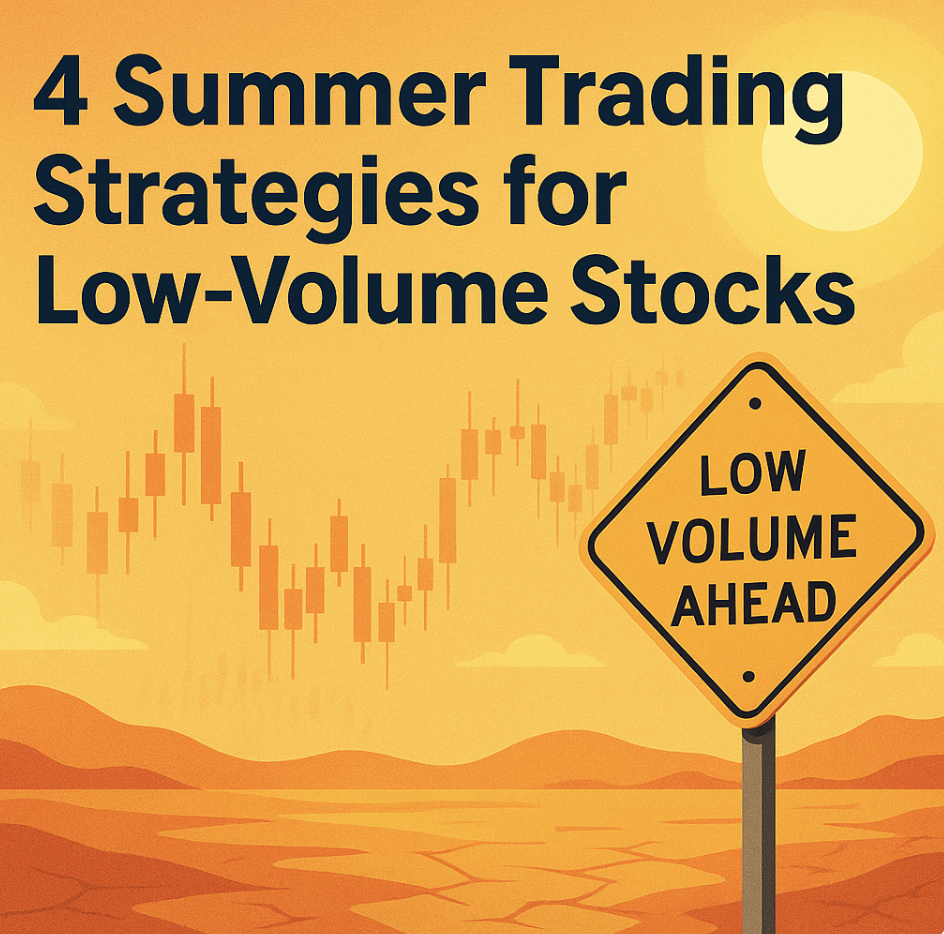4 Strategies for Trading Low-Volume Summer Stocks
4 Strategies for Trading Low-Volume Summer Stocks
By: Shane Neagle
Trading in the summer presents unique problems for the active trader. With fewer institutional participants with retail volume lower, liquidity typically dried up, leading to wider spreads, thinner order books, and more volatile prices. For traders who are looking for momentum, technical setups, and playing technical analysis and price confirmation, the summer lulls will often feel more like you are sliding through a minefield of false breakouts and biased purse movements.
Even if low-volume reflects a change, it does not mean opportunities evaporate. The opportunities will change and be reflected in the execution of trades. Utilizing time frames to create a profit can be reduced. However, completing these trades and successfully profiting June through late September is much harder to depend on as a trader. Fortunately for traders, low-volume environments and markets demand a change in how to identify setups, how to mitigate risk, and when to execute trades.
Instead of executing forced or excessive trades, intelligent market participants can change their approach by simply changing trading style to fit the market conditions.
Here are four applicable strategies to improve your trading for low-volume stocks during the trading months of summer. From the manner volume is considered to the best timing to enter a position around peak liquidity, these speculative trading strategies are intended tto allow traders to remain selective, reduce risks, and allow traders to book winners in the summer market when the average trader does not have opportunity.
Prioritize Relative Volume Over Absolute Volume
During the slower pace of summer, absolute volume numbers can often be misleading. A stock trading 2 million shares might seem active, but when we look at the fact that it usually trades an average of 5 million shares over that time, then the volume is actually below average. That’s why relative volume (RVOL) is useful—we can look at volume in relation to a stock’s average volume at the same time of day. A relative volume signal of 2.0 would mean the stock has traded at twice the average volume of activity of that time of day.
Relative volume is like radar, giving traders insight into a stock that has true relative volume, even when overall market volume is low and/or particularly slow. As we are approaching summer and low liquidity conditions, I would rather look at relative volume versus raw volume any day of the week.
Of course, using tools like Trade Ideas’ Relative Volume scan makes it easy for traders to spot these anomalies almost in real time during the trading day. These tools can filter for stocks that trade significantly more than defined baseline volume particularly during low volume periods.
For example, let’s say a low-float biotech trading stock typically trades 100,000 shares per day. A news catalyst hits and all of a sudden, volume starts to spike up to 500,000 volume by around mid-morning—this RVOL signal might say RVOL is above 5.0, which indicates that with that level of RVOL, a significant momentum move on that stock is likely going to occur.
In a brief session preview, traders could get just a few relevant alerts instead of dozens or hundreds of insignificant volume spikes. This keeps focus tightly and reduces the filtered noise from low-value alerts.
When liquidity isn’t plentiful and false signals are more frequent, relative volume provides a clearer, context-driven picture. It draws attention to notable “wicked” interest, provides more clarity and timing precision, supports better decision making and helps reduce unnecessary reactions to random price fluctuation.
Use Wider Stops and Smaller Position Sizes
Low volume markets—most notably during months in summer—yield bid-ask spreads that are sometimes double as wide and price action that is even more random. It is much easier to be stopped out of a trade even when the price setup is still valid. Traders, by habit, will have longer stop-loss levels in more busy times of the year when they are getting in and out of trades with tight intra-day ranges. When you continue to do this in thin trading conditions you will be constantly and unnecessarily being stopped out.
Egrew’s recommendation for dealing with low volume setups, is to look at volatility-based measures such as Average True Range (ATR). Average True Range measures how much a given stock usually moves over time. Ultimately, stop-loss placement becomes easier because you are placing them outside of the “normal noise” of the market thus decreasing the chances of getting knocked out of the trade due to arbitrary price fluctuations. For example, if you need to use a 50-cent stop-loss, instead of a flat 50-cent stop-loss you would use 1.2x the 14-period ATR to determine an exit level that could change.
That said, where stops are very good, traders must reduce their position sizes to accommodate for wider stops. The longer the stop-loss, the longer the distance from which price is getting from entry to the loss on your trade. This is why it is very to position sizes for the same amount of dollar risk per trade. For example, if each trade you take you are willing to risk $200. If you have been using a $1.00 stop-loss level on your setup instead of the 1.5 stop-loss you are using now, you also cut your maximum trade size by 33%.
Having wide stops and a smaller position size gives the best of both worlds: time for trades to develop without exiting prematurely, while also providing enough risk control to help keep your capital intact against any unexpected volatility. It also allows for psychological clarity – allowing traders to hold on to trade longer without the anxiety of being “too big” or too tight.
When trading in thin markets where price whipsaws are plentiful, adjusting for volatility and size will be a key attrition strategy for survival. It will allow for participants to remain active – whilst remaining protected.
Avoid Midday Choppiness—Time Your Trades Around Volume
When the summer markets have low volume, timing is essential. Summer markets tend to have a higher volume at the beginning and end of the day. In the middle of the day, the volume and volatility tend to drop significantly, which leads to price action that is often range-bound and full of false signals in the middle session of the day. In other words, unless you are trading with a very large amount of capital in low and inconsistent volume environments, the middle of the day doesn’t represent the best place to take a position, and they are more likely to be higher risk trades.
The first 90 minutes of the trading day and the last 60 minutes of the trading day are statistically the most active times during any trading day. At these times, liquidity is greater, institutional order flow is greater and trading trends are clearer. According to Nasdaq, the openings and closings auctions continue to represent a disproportional amount of daily volume, with over 20% of daily volume in many instances, and that phenomena transcends just the auction.

Conversely, the middle of the day represents potential for “chop”, which is sideways movement with little follow through. There is an increase of fake breakouts based on low liquidity, slippage in orders and whipsaws when trying to catch small moves. Many professional traders refuse to trade the middle of the day all together and use the time to review setups and reset alerts.
A tool like Trade Ideas’ instantaneous volume scanning can expose volume and volatility changes intra day. When used properly, it allows traders to prepare to recognize spikes and volume moves at predetermined times or news catalysts and potential trades in even the slowest of sessions. Carefully controlling intraday volume flow helps ensure you’re not taking trades in dead zones or areas where they won’t have a clean price movement.
When trading during the summer, concentrating your efforts around the open and close – while allowing the market to come to you – can substantially reduce the clutter and comfort and quality of trades.
Be Selective and Watch for False Breakouts
False breakouts are a typical predicament in thinly traded markets—and more frequently in the quieter summer months. These result from the price action moving above a resistance area (or below support) only to return back in the direction of the trend. It wastes many traders’ time, who naively jump in at a breakout level only to be fooled by the market’s head fake that trapped them. These head fakes happen more often in low liquidity conditions; the buyer or seller simply could not maintain their momentum from the stagnant market.
This is why confirmation is so important. Traders should always look for a high relative volume and price action to follow before entering a trade based on breakouts. A single candlestick wick above resistance without significant volume will rarely suffice. Investopedia explains, breakouts with high volume have a higher probability of success than breakouts from low volume that tend to fail shortly thereafter.
Another filter is the strength of news/catalysts. If a breakout in a stock occurs without any fresh catalyst (meaning no earnings per share report, no analyst upgrade, no sector movement), it will be suspected to fail. Seek setups where momentum has a necessary fundamental or technical reason to follow through.
When markets are weak and without energy due to seasonal conditions, stocks that pay dividends – particularly those with an established payout history – may provide a bit more stability. Dividend names tend to attract long-term investors and institutional capital, which makes it easier to find support and likely allows for more stability around holding i.e. less moving around. When there is less volatility, traders are less likely to get false signals when volume is lower than normal.
As we discussed last week, platforms like TradeWave and the Go No Go trend indicator provide insight into trend strength and can also help limit your exposure to these movements by providing you with a visual of these trades or setups without confirmation. When you use these tools with your volume and news filters, you can use them in your trading system to improve the quality of trades and your conviction to hold the trade, which is key in addressing the noise in the summer market.
Conclusion
Summer trading is different in many ways than other, more active seasons. Although lower volume and participation have their advantages, traders must switch their mentality to fit the time of the year so that they can avoid thinner liquidity, wider spreads, and false signals. Change is not optional, it is imperative if you want to protect capital and remain successful.
By making relative volume your primary focus, utilizing bigger stops and smaller position sizes, timing when you are going to trade around high volume periods, and filtering out setups that you are unsure of, you can remain disciplined and focused, even during a more difficult time of year. Tools like Trade Ideas Relative Volume scanner, TradeWave, and Go No Go indicator might assist with lessening the confusion when the market gets tough.
Ultimately, patience and precision are key when investing in low volume summer stocks. Allow the opportunities to find you and use everything you can to make sure you are acting on the valuable ones.

